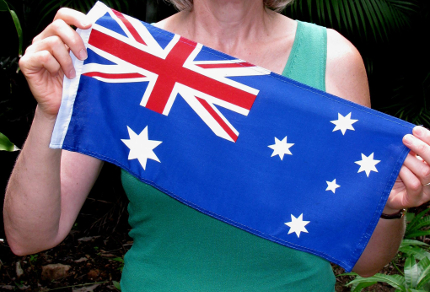While stretching on the living room floor, I noticed – in a small triangle of faintly-lit sky bordered by roof and trees – black flying foxes streaming past overhead, heralded eastward by the dawn. Then I ran and walked alongside the golf course and through Bicentennial Park, with the city’s avian choristers belting it out around me. Purple clouds billowed up into a pink sunrise that transformed to gold before my eyes, and then faded into streaked, dirty blue.
My legs and lungs felt strong, the result of many hours spent panting and sweating upward on Tassie bushwalking tracks. I was reminded of how, during ten and a half months of climbing low peaks and tramping hundreds of kilometres of tracks in New Zealand, our sons Dainis and Janis metamorphosed into mountain goat kids who scampered up and down rocky slopes undaunted by heights or edges. When we returned to Canada, they and Vilis and I were so much stronger than we all had been on our arrival in New Zealand. Vilis and I hope the same will be true for us as a result of this time in Australia.
On my return to the house, I tackled the first two blog posts from our Victoria/Tasmania trip. Later, during the evening, Vilis and I attended a history lecture at the Townsville central library in Thuringowa. Titled “Long Skirts and Hot Suppers: Negotiating the New in North Queensland,” the lecture was presented by Dianne Lawrence, an Honorary Research Fellow at Lancaster University in the United Kingdom. Her talk focussed on the migrant experience of relatively prosperous English women in various British colonies during the late 19th and early 20th centuries, including Australia and, in particular, North Queensland. At its core was a discussion of how, through dress and meal presentation, these women maintained ties between old and new homes and upheld the social and moral standards of their homeland.
At first, the thesis seemed a bit of a stretch to me, but I kept in mind that the women Lawrence had researched belonged to the social elite of the colonies. Highly literate, they had written journals, diaries, and letters that Lawrence was able to obtain and study, and which revealed an overwhelming (quite literally, in terms of the change in climate between England and the tropics of North Queensland) obsession with wearing the same formal, long-sleeved and high-necked fashions and arranging the same hot, heavy suppers they had in England. One woman wrote of ironing her voluminous dresses on a day with a temperature of 108°F (40.5°C). A photograph showed a man and woman seated at a dining table in an open veranda cluttered with the paraphernalia of the tropics (including a couple of sulphur-crested cockatoos), but with the table covered with a heavy, unwrinkled white tablecloth and adorned with napkins in napkin rings, and the woman clothed from head to toe in typical British fashion of the day.
Colonial English men in North Queensland, on the other hand, adopted a more relaxed standard with respect to clothing, as indicated by photographs showing men wearing short-sleeved shirts sitting next to women attired in complete formal dress. Lawrence attributed this dichotomy to the fact that it was the women who were seen as the upholders of social and moral authority in their families and in the colonies, and that their formal dress was maintained to reinforce this image even when it wasn’t practical. The attempts to present meals with the same style and of the same nature as in England, Lawrence again attributed to the all-important maintenance of the British standard, as well as to attempting to create a bond between old and new homes.
Life in North Queensland, however, presented these society-conscious women with challenges to maintaining acceptable fashion and table meat. Fabrics were limited, necessitating the recycling and alteration of garments, at which the women were skilled due to their training in needlework. Lawrence asserted that, by adding individual touches to their alterations, the women marked their place in society and elevated what some might consider a mundane task to an activity of moral worth and social prominence. She corroborated this assertion by readings from letters in which the discussion of altering garments figured largely, when no mention was made at all of what we might think of as more profound (but “intimate” topics), such as being pregnant or caring for children.
The shortage of good legs of pork or mutton to be found in the wilderness necessitated the preparation of roasts of kangaroo, or as one woman described in a letter, “very good soup made from those pretty, lemon-crested cockatoos.” Kitchens were located in separate buildings from houses, which kept houses cleaner and reduced the chances of them being destroyed by fire. The removal of kitchens from houses also kept servants, most of whom were Aboriginals, Islanders, or Chinese, at a distance from the women and their families, who perceived themselves as being both socially and racially superior to the ‘natives.’
After the lecture, I spoke briefly with Dr. Lawrence, who spent three years researching her topic for a Ph.D. Particularly inspiring to me was the fact that she hadn’t begun her studies until she was 56 years old.
On leaving the library, Vilis and I wandered over to the Soundshell near the library and listened to a brass band and flautist perform the old Elvis Presley hit, “I Can’t Help Falling in Love with You” on the same stage where the toad buster awards were presented yesterday morning. The trumpets sounded clean and mellow, their heady melody wafting out into evening warmth far more suited to Elvis than to long skirts and hot suppers.


